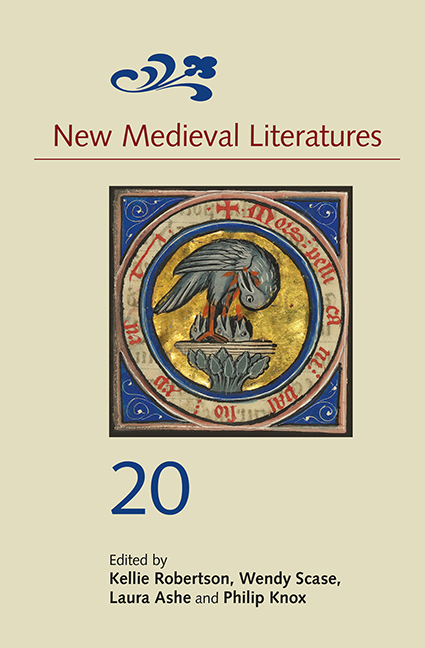Book contents
- Frontmatter
- Contents
- List of Illustrations
- List of Abbreviations
- 1 Lion-Keu-Coupé: A Missing Link in Yvain or Le Chevalier au Lion
- 2 John of Howden’s Rossignos and the Sounds of Francophone Devotion
- 3 ‘Wereyed on every side:’ Chaucer’s Troilus and Criseyde and the Logic of Siege Warfare
- 4 ‘Ave ave ave [ave]:’ The Multilingual Poetics of Exuberance in Bruder Hans
- 5 Performative Typology, Jewish Gender and Jesus’s Queer Romance in the York Corpus Christi Plays
- 6 Locating Charles d’Orléans: In France, in England and Out of Europe
- 7 Urinals and Hunting Traps: Curating Fifteenth-Century Pragmatic Books
1 - Lion-Keu-Coupé: A Missing Link in Yvain or Le Chevalier au Lion
Published online by Cambridge University Press: 30 April 2020
- Frontmatter
- Contents
- List of Illustrations
- List of Abbreviations
- 1 Lion-Keu-Coupé: A Missing Link in Yvain or Le Chevalier au Lion
- 2 John of Howden’s Rossignos and the Sounds of Francophone Devotion
- 3 ‘Wereyed on every side:’ Chaucer’s Troilus and Criseyde and the Logic of Siege Warfare
- 4 ‘Ave ave ave [ave]:’ The Multilingual Poetics of Exuberance in Bruder Hans
- 5 Performative Typology, Jewish Gender and Jesus’s Queer Romance in the York Corpus Christi Plays
- 6 Locating Charles d’Orléans: In France, in England and Out of Europe
- 7 Urinals and Hunting Traps: Curating Fifteenth-Century Pragmatic Books
Summary
At the heart of Yvain, or Le Chevalier au Lion (c.1177–81), Chretien de Troyes's ‘best constructed romance’ according to the great medievalist Jean Frappier, there is a missing link: the lion's tail, the tip of the tail to be precise. It goes missing at the midpoint of the romance, as Yvain ushers in his new identity as the heroic chevalier au lion, the knight of the lion or lion-knight. Having had his madness cured by the lady of Noroison and rescued her from her aggressor (lines 2888–3340; 291–96), Yvain hears a loud cry, traces the noise to its origin and encounters a lion with its tail caught between the jaws of a serpent:
Mesire Yvains pensis chemine
Tant qu’il vint en une gaudine;
Et lors oy en mi le gaut
Un cri mout dolereus et haut,
Si s’adrecha leus vers le cri
Chele part ou il l’ot oÿ.
Et quant il parvint chele part,
Vit .i. lion en .i. essart
Et .i. serpent qui le tenoit
Par le keue, si li ardoit
Toutes les rains de flambe ardant. (lines 3341–51)
(Absorbed in his thoughts, Sir Yvain rode until he entered a forest, and then he heard a loud cry of pain from the trees. He turned in the direction of the cry. When he reached a clearing, he saw a lion and a serpent, which was holding the lion by the tail and scorching his haunches with burning fire. [296–97])
He decides to save the lion (lines 3356–75; 297), but in order to do so he must cut off a small part of its tail even after he has killed the serpent:
A l’espee fourbie et blanche
Va le felon serpent requerre,
Si le trenche jusques en terre
Et les .ii. moitiez retronchonne;
Fiert et refiert et tant l’en donne
Que tout l’amenuse et depieche.
Mais de le keue une pieche
- Type
- Chapter
- Information
- New Medieval Literatures 20 , pp. 1 - 45Publisher: Boydell & BrewerPrint publication year: 2020



